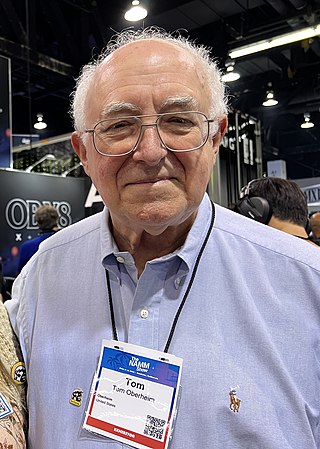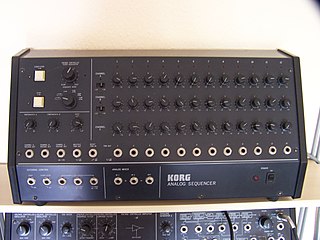
An electronic musical instrument or electrophone is a musical instrument that produces sound using electronic circuitry. Such an instrument sounds by outputting an electrical, electronic or digital audio signal that ultimately is plugged into a power amplifier which drives a loudspeaker, creating the sound heard by the performer and listener.

Robert Arthur Moog was an American engineer and electronic music pioneer. He was the founder of the synthesizer manufacturer Moog Music and the inventor of the first commercial synthesizer, the Moog synthesizer, which debuted in 1964. In 1970, Moog released a more portable model, the Minimoog, described as the most famous and influential synthesizer in history. Among Moog's honors are a Technical Grammy Award, received in 2002, and an induction into the National Inventors Hall of Fame.

The Minimoog is an analog synthesizer first manufactured by Moog Music between 1970 and 1981. Designed as a more affordable, portable version of the modular Moog synthesizer, it was the first synthesizer sold in retail stores. It was first popular with progressive rock and jazz musicians and found wide use in disco, pop, rock and electronic music.

Modular synthesizers are synthesizers composed of separate modules for different functions. The modules can be connected together by the user to create a patch. The outputs from the modules may include audio signals, analog control voltages, or digital signals for logic or timing conditions. Typical modules are voltage-controlled oscillators, voltage-controlled filters, voltage-controlled amplifiers and envelope generators.

Oberheim is an American synthesizer manufacturer founded in 1969 by Tom Oberheim.
Keytar is a keyboard instrument similar to a synthesizer or MIDI controller that is supported by a strap around the neck and shoulders, similar to the way a guitar is held.

The Yamaha CS-80 is an analog synthesizer introduced by Yamaha Corporation in 1977. It supports true 8-voice polyphony, with two independent synthesizer layers per voice each with its own set of front panel controls, in addition to a number of hardwired preset voice settings and four parameter settings stores based on banks of subminiature potentiometers.
Electronic Music Studios (EMS) is a synthesizer company formed in Putney, London in 1969 by Peter Zinovieff, Tristram Cary and David Cockerell. It is now based in Ladock, Cornwall.

Moog Music Inc. is an American synthesizer company based in Asheville, North Carolina. It was founded in 1953 as R. A. Moog Co. by Robert Moog and his father and was renamed Moog Music in 1972. Its early instruments included the Moog synthesizer, followed by the Minimoog in 1970, both of which were highly influential electronic instruments.

The Moog synthesizer is a modular synthesizer invented by the American engineer Robert Moog in 1964. Moog's company, R. A. Moog Co., produced numerous models from 1965 to 1981, and again from 2014. It was the first commercial synthesizer and established the analog synthesizer concept.
Arturia is a French electronics company founded in 1999 and based in Grenoble, France. The company designs and manufactures audio interfaces and electronic musical instruments, including software synthesizers, drum machines, analog synthesizers, digital synthesizers, MIDI controllers, sequencers, and mobile apps.

The Moog Liberation was one of the first commercially produced "keytar" synthesizers, released in 1980 by Moog Music. The instrument is comparable to the Moog Concertmate MG-1 and the Moog Rogue, but it is most closely related to the Moog Prodigy; however, as a keytar, the Liberation was designed to be played in the same posture as one would play a guitar.

PAiA Electronics, Inc. is an American synthesizer kit company that was started by John Simonton in 1967. It sells various musical electronics kits including analog synthesizers, theremins, mixers and various music production units designed by founder John Simonton, Craig Anderton, Marvin Jones, Steve Wood and others.

Electronic Music Laboratories, commonly abbreviated to EML, was a synthesizer company founded in 1968 in Vernon, Connecticut, by four engineers. It manufactured and designed a variety of synthesizers sharing the same basic design but configured in different ways.

Thomas Elroy Oberheim, known as Tom Oberheim, is an American audio engineer and electronics engineer best known for designing effects processors, analog synthesizers, sequencers, and drum machines. He has been the founder of four audio electronics companies, most notably Oberheim Electronics. He was also a key figure in the development and adoption of the MIDI standard. He is also a trained physicist.
John Scott Bowen is an American sound designer known for his early work with synthesizers.

Michael Lehmann Boddicker is an American film composer and session musician, specializing in electronic music. He is a three times National Academy of Recording Arts and Sciences (N.A.R.A.S.) Most Valuable Player "Synthesizer" and MVP Emeritus, he was awarded a Grammy as a songwriter for "Imagination" from Flashdance in 1984. He is the president of The Lehmann Boddicker Group.

An analog sequencer is a music sequencer constructed from analog (analogue) electronics, invented in the first half of the 20th century.

Herbert Arnold "Herb" Deutsch was an American composer, inventor, and educator. Until his death in 2022, he was professor emeritus of electronic music and composition at Hofstra University. He was best known for co-inventing the Moog synthesizer with Bob Moog in 1964.

The Arturia MiniBrute is a synthesizer manufactured by Arturia. Although the MiniBrute was the first piece of analog hardware created by Arturia—which had previously exclusively marketed software synthesizers—it generated strong sales.
















